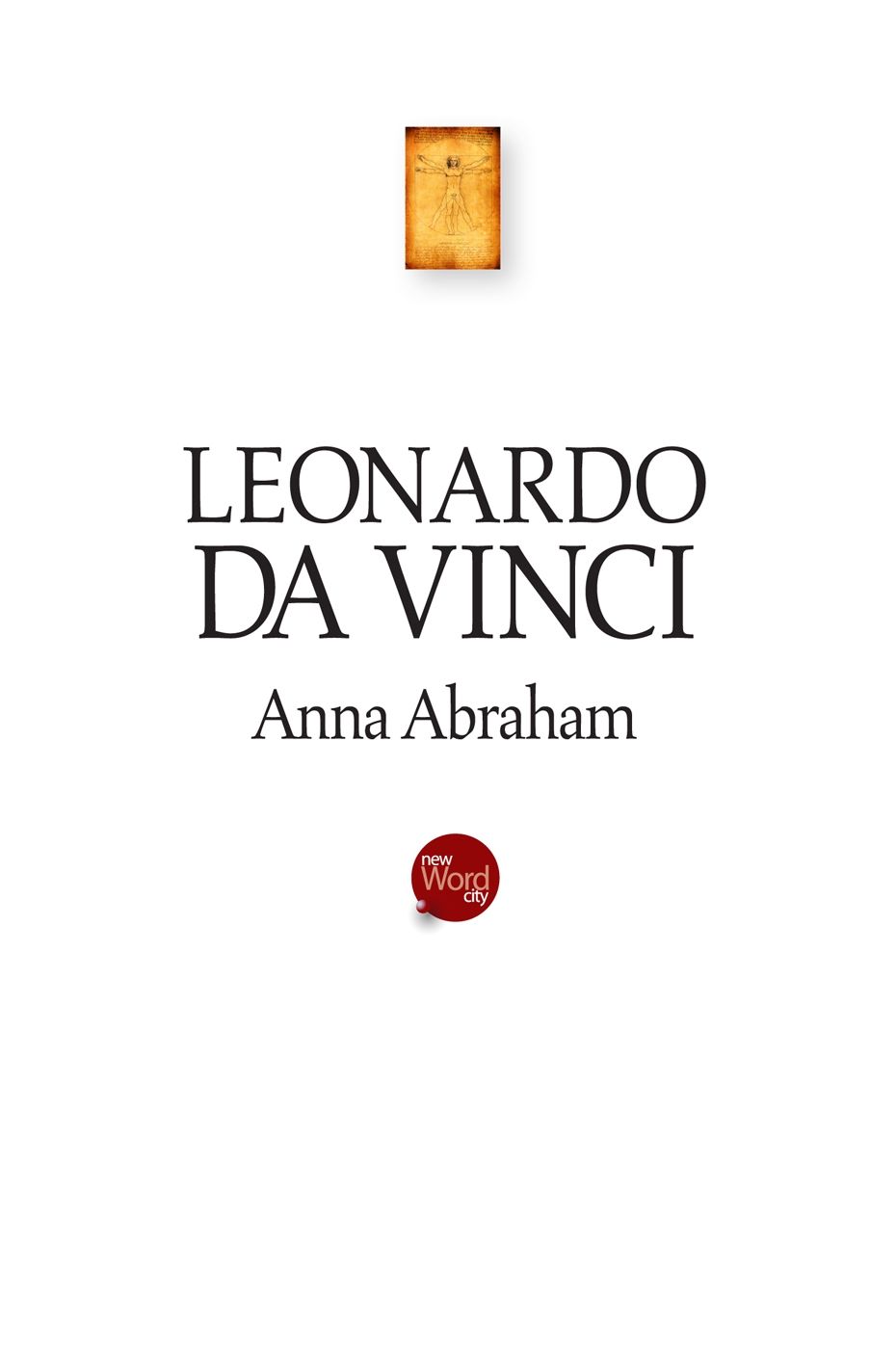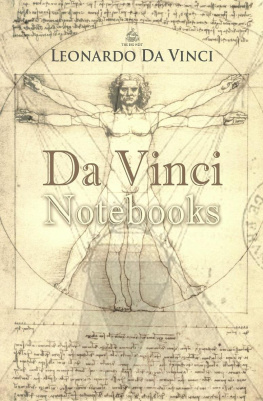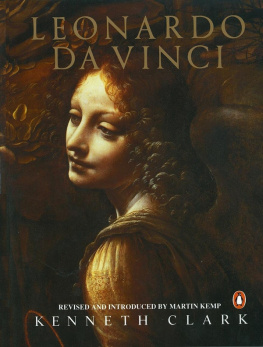Anna Abraham - Leonardo da Vinci
Here you can read online Anna Abraham - Leonardo da Vinci full text of the book (entire story) in english for free. Download pdf and epub, get meaning, cover and reviews about this ebook. year: 2014, publisher: New Word City Inc., genre: Non-fiction. Description of the work, (preface) as well as reviews are available. Best literature library LitArk.com created for fans of good reading and offers a wide selection of genres:
Romance novel
Science fiction
Adventure
Detective
Science
History
Home and family
Prose
Art
Politics
Computer
Non-fiction
Religion
Business
Children
Humor
Choose a favorite category and find really read worthwhile books. Enjoy immersion in the world of imagination, feel the emotions of the characters or learn something new for yourself, make an fascinating discovery.

- Book:Leonardo da Vinci
- Author:
- Publisher:New Word City Inc.
- Genre:
- Year:2014
- Rating:4 / 5
- Favourites:Add to favourites
- Your mark:
- 80
- 1
- 2
- 3
- 4
- 5
Leonardo da Vinci: summary, description and annotation
We offer to read an annotation, description, summary or preface (depends on what the author of the book "Leonardo da Vinci" wrote himself). If you haven't found the necessary information about the book — write in the comments, we will try to find it.
Leonardo da Vinci — read online for free the complete book (whole text) full work
Below is the text of the book, divided by pages. System saving the place of the last page read, allows you to conveniently read the book "Leonardo da Vinci" online for free, without having to search again every time where you left off. Put a bookmark, and you can go to the page where you finished reading at any time.
Font size:
Interval:
Bookmark:


Leonardo da Vinci personified the Renaissance , the extraordinary age in which he lived. Born a bastard in a hillside town in northern Italy, he became the protg of princes, popes, and kings. Though many of his projects went unfinished, he set new benchmarks in painting and created stunning works of architecture, sculpture, and the written word. He mastered so many branches of science that scholars still debate whether he was more accomplished as an anatomist, botanist, cartographer, engineer, geographer, or naturalist.
By the time he died in 1519, Leonardo seemed to have accomplished his boyhood ambition: I wish to work miracles. Nevertheless, he died unhappy, believing he had failed to live up to his potential.
Leonardos genius set the standard that Western civilization still struggles to attain, and he serves as a reminder of the untold breadth and depth a single brilliant mind can span.
After the gloom and superstitions of the Middle Ages , the Renaissance that began in the early 1400s dispelled the immense cloud suspended over a Europe devastated by plague and war. A new spirit of intellectual rigor and scientific inquiry spread through universities and monasteries, where unconventional notions of liberty were born and depictions of nature appeared in a fresh guise. Artists and sculptors, confined for generations within the conventions of medieval art, embraced and explored naturalism and new forms of human expression. It appeared to many that a new world was emerging, one where people would be freed by reason and knowledge and all the secrets of the universe could be found and put to use.
At the center of this vortex was Florence , but as the new era expanded, it became evident that the Renaissance would transform all of European civilization and eventually the world.
The man who came to personify the era, Leonardo da Vinci was born on April 15, 1452. Widely admired in his own day, he left a posthumous treatise on the art of painting - 7,000 pages of manuscripts and 3,000 pages of notes filled with his writings and drawings. Yet at his core, he remains a puzzle. Leonardo is the Hamlet of art history, wrote scholar and art critic Kenneth Clark , whom each of us must recreate for himself.
What we know of him is pieced together from surviving church and town records, a few contemporary letters, and brief accounts of his life written in the century after his death. Scholars and historians have expanded that material into nuanced, insightful studies, but they remain partly speculations. His mind and personality seem to us superhuman, noted art historian Helen Gardner , the man himself mysterious and remote.
Leonardo sprang from the provincial village of Vinci, and lacking the pedigree to warrant a surname, he made do with da Vinci - from Vinci. The town was a long days ride - and an even longer cultural journey - from Florence twenty miles away. His family history gave no hint of greatness. Leonardos father, Piero, was a notary charged with handling the legal affairs of the town. The people of Vinci called him Ser or Master out of respect. Ser Piero da Vinci was a link between the slow, backward town - a cluster of stone buildings around a castle and a church - and the wealth and glamour of Florence, where he had many friends among the citys artists, craftsmen, and merchants.
Leonardo was born from Pieros liaison with a young woman named Caterina. She is usually described as a peasant, but the only early biographer who mentions her - Anonimo Gaddiano, who wrote about the lives of several Renaissance artists in 1540 - said she came of good blood. The baby was baptized the next day in the parish church in a rough stone font. Some eight months later, Piero married the bride his family had chosen: sixteen-year-old Albiera di Giovanni Amadori, daughter of another prosperous notary. After Albiera proved childless, young Leonardo, who had spent his first five years in his mothers house, moved in with Piero and Albiera in their home just outside the castle walls. There he found ample affection from his stepmother and Pieros younger brother, Francesco, who made time to play with Leonardo and take him for long walks in the Tuscan countryside.
Vinci sat high on the slopes of Mount Albano, between the olive trees and orchards of Lucca and the rugged mountain range with its rushing streams, twisting paths, and dramatic vistas, and uncle and nephew delighted in exploring the valley below Florence. These walks gave the boy a love of nature and its creatures. Giorgio Vasari , himself an accomplished painter, wrote of Leonardo in 1550: He took an especial delight in animals of all sorts, which he treated with wonderful love and patience. For instance, when he was passing the places where they sold birds, he would often take them out of their cages with his hand, and having paid whatever price was asked by the vendor, he would let them fly away into the air, giving them back their lost liberty.
Leonardo himself told only two stories of his childhood. The first, which he took as an omen, has usually been interpreted as a fantasy, but he wrote of it as a vivid vision of a hawk hovering over him:... I was in my cradle... a kite came to me, and opened my mouth with its tail, and struck me several times with its tail inside my lips. Leonardo was taking notes on the flight of birds when the memory struck him, and he preceded the story with this line: Writing like this so particularly about the kite seems to be my destiny, since the first memory...
The second story rings with both authenticity and hidden meanings. He wrote that while walking alone, I came to the mouth of a huge cavern before which for a time I remained stupefied... my back bent to an arch, my left hand clutching my knee, while with the right I shaded my eyes; and I bent first one way and then another in order to see whether I could make out anything inside, though this was almost impossible because of the intense darkness within. And after remaining there for a time, suddenly there were awakened in me two emotions, fear and desire: fear of the dark, threatening cavern and desire to see whether there might be any marvelous thing in it.
Leonardo seemed not much different from other boys, but the older he grew, the more he felt like a misfit in Vinci not just because he was illegitimate and a stepchild, but because of his intense intelligence and curiosity.
Leonardo described himself as an unlettered man, because he had not been taught the formal language of Latin. His education was haphazard and informal, and he dropped a subject as soon as he learned what he wanted to know. He would have been proficient at his early lessons if he had not been so volatile and unstable, Vasari wrote. He set himself to learn many things only to abandon them almost immediately. When he began to learn arithmetic, in a few months he made such progress that he bombarded the master who was teaching him with questions and problems and very often outwitted him. Perhaps because he was left-handed, he took to his famous mirror-writing - from right to left on the page, with each letter formed in reverse. Viewed in a mirror, it looks like normal handwriting. The boy was fond of music, Vasari reported, and he never left off drawing and sculpting, which suited his imagination better than anything.
As he grew older, Leonardo regretted this magpie style of learning, but its doubtful he could have absorbed half as much had he been more methodical. In any case, he could not have progressed in a more formal education; because Piero never married Caterina and legitimized him, Leonardo could not have entered a university.
Font size:
Interval:
Bookmark:
Similar books «Leonardo da Vinci»
Look at similar books to Leonardo da Vinci. We have selected literature similar in name and meaning in the hope of providing readers with more options to find new, interesting, not yet read works.
Discussion, reviews of the book Leonardo da Vinci and just readers' own opinions. Leave your comments, write what you think about the work, its meaning or the main characters. Specify what exactly you liked and what you didn't like, and why you think so.











